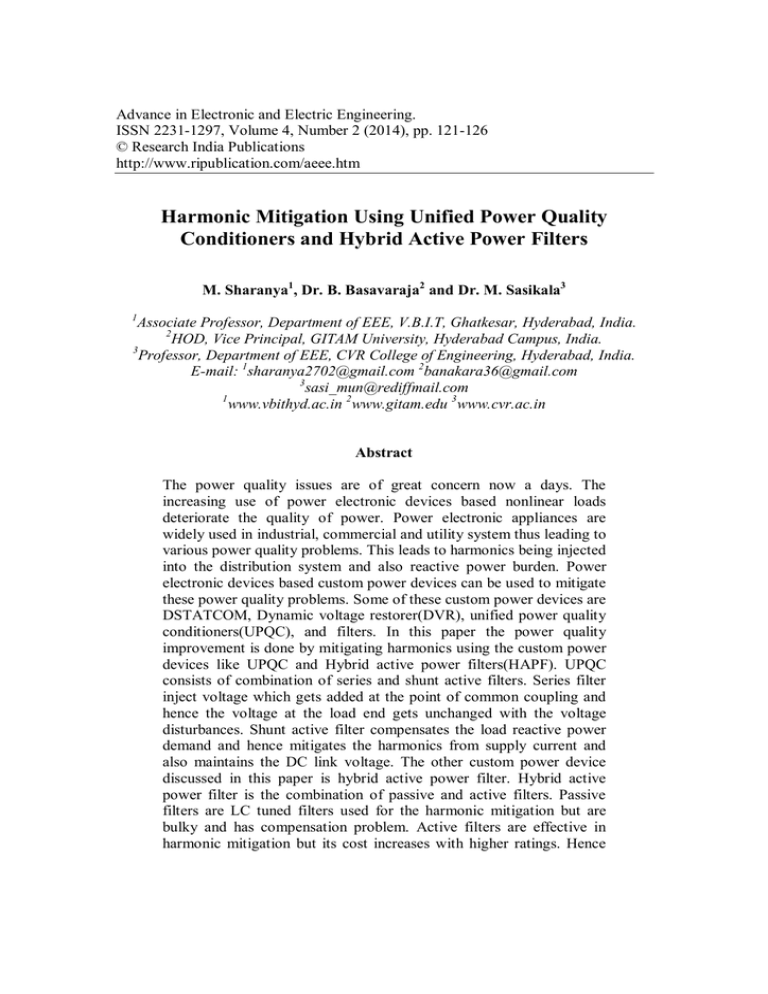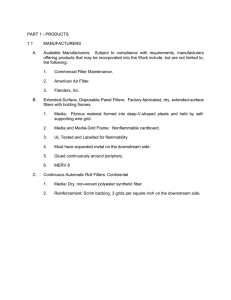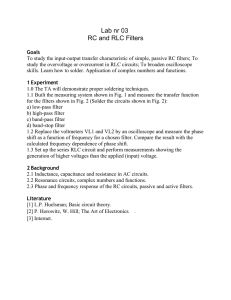Harmonic Mitigation Using Unified Power Quality Conditioners and
advertisement

Advance in Electronic and Electric Engineering. ISSN 2231-1297, Volume 4, Number 2 (2014), pp. 121-126 © Research India Publications http://www.ripublication.com/aeee.htm Harmonic Mitigation Using Unified Power Quality Conditioners and Hybrid Active Power Filters M. Sharanya1, Dr. B. Basavaraja2 and Dr. M. Sasikala3 1 Associate Professor, Department of EEE, V.B.I.T, Ghatkesar, Hyderabad, India. 2 HOD, Vice Principal, GITAM University, Hyderabad Campus, India. 3 Professor, Department of EEE, CVR College of Engineering, Hyderabad, India. E-mail: 1sharanya2702@gmail.com 2banakara36@gmail.com 3 sasi_mun@rediffmail.com 1 www.vbithyd.ac.in 2 www.gitam.edu 3 www.cvr.ac.in Abstract The power quality issues are of great concern now a days. The increasing use of power electronic devices based nonlinear loads deteriorate the quality of power. Power electronic appliances are widely used in industrial, commercial and utility system thus leading to various power quality problems. This leads to harmonics being injected into the distribution system and also reactive power burden. Power electronic devices based custom power devices can be used to mitigate these power quality problems. Some of these custom power devices are DSTATCOM, Dynamic voltage restorer(DVR), unified power quality conditioners(UPQC), and filters. In this paper the power quality improvement is done by mitigating harmonics using the custom power devices like UPQC and Hybrid active power filters(HAPF). UPQC consists of combination of series and shunt active filters. Series filter inject voltage which gets added at the point of common coupling and hence the voltage at the load end gets unchanged with the voltage disturbances. Shunt active filter compensates the load reactive power demand and hence mitigates the harmonics from supply current and also maintains the DC link voltage. The other custom power device discussed in this paper is hybrid active power filter. Hybrid active power filter is the combination of passive and active filters. Passive filters are LC tuned filters used for the harmonic mitigation but are bulky and has compensation problem. Active filters are effective in harmonic mitigation but its cost increases with higher ratings. Hence 122 M. Sharanya et al hybrid active filter provides cost effective harmonic mitigation solution. The active filters are designed using IGBT based switches and are controlled by using PI controllers. Simulation is done using MATLAB/SIMULINK environment and the results show that both these custom power devices, UPQC and HAPF reduces the harmonics. The total harmonic distortion (THD) values by this control method is reduced to less than 5% as per IEEE standards. The proposed controls scheme provides better steady state and dynamic responses. Keywords: Power quality; custom power device; DSTATCOM; DVR; UPQC; HAPF; MATLAB/SIMULINK; THD. 1. Introduction In distribution power systems the power quality problems are not new, but the awareness of customer to these problems has increased recently. The quality of power at the point of commoncoupling (PCC) with the utility grid is governed by the various standards and the IEEE-519 standard is widely accepted. Flexible solutions to these power quality problems are obtained by using power electronic converters that is by using custom power devices. (Nikita Hari et al, 2011) Various power quality problems like: sag, swell, voltage imbalance, flickers harmonics and reactive currents can be compensated by using UPQC. UPQC is a combination of shunt and series active filters connected through a common dc link capacitor. The series active filter injects voltage, which gets added at the PCC and the main objectives of shunt active filter are: to compensate for the load reactive power demand and unbalance, to eliminate the harmonics from the supply current, and to regulate the common dc link voltage. (Nikita Hari et al, 2011) Another custom power device used for the power quality improvement is Hybrid active power filters. Conventional passive filters compensate reactive power along with harmonics and are of low cost and have simple structure. But these have the problem of tuning, resonance and are bulky. To overcome these problems active filters are used which are best suited for the compensation under dynamic load conditions. The main drawback of these filters is that it’s cost increases with the increase in the ratings. Hence hybrid active power filters are used which is the combination of both passive and active filters and has the advantages of both these filters. (P. Thirumoorthy et al, 2012; M. Salehifar et al, 2010) 2. Unified Power Quality Conditioner The UPQC is a custom power device that has shunt and series active filters, connected back to back on dc side and sharing a common DC capacitor as shown in Fig 1. It has two voltage source inverters (VSIs) that are connected to a common DC energy storage capacitor. One of these two VSIs is connected in series with the feeder and the other is connected in parallel to the same feeder. (Nikita Hari et al, 2011) Harmonic Mitigation Using Unified Power Quality Conditioners and Hybrid 123 Fig. 1: Model of UPQC. 2.1 Control of UPQC The UPQC system controller consists of series APF and shunt APF controller. APF controller generates the reference current signal measuring the load voltage, load current, injected current and capacitor voltage. APF controller protects the overall system by closing the firing pulses going to IGBT drivers. Shunt APF also regulates the DC link voltage. Hysteresis control technique is used to generate the gate switching pulses of APF. Series APF controller generates the reference voltage and sag detection signals measuring the supply voltages. Series APF controller is based PLL. The reference voltage signal and fault detection signal are extracted simultaneously. Series APF controller uses independent fault detection method for each phase and thus each H-bridge inverter is controlled independently. Sinusoidal PWM control technique is used to generate the gate switching pulses of Series APF. 500 0 -500 0 Load current Source voltage 2.2 Simulation results of UPQC Fig 2 and fig 3 shows the simulation results for the case where the system is in steady state. Due to power electronic load the current waveform is distorted and is unbalanced. Voltage waveform is also distorted. 2000 4000 6000 Time(sec) Fig2: 2 Source Sourcevoltage voltage without UPQC Fig. without UPQC. 50 0 -50 0 Fig. 2000 4000 6000 Time(sec) 3 Load current withoutUPQC. UPQC 3:FigLoad current without 8000 124 M. Sharanya et al Fig. 4 and Fig 5 shows the results after UPQC is connected to the system. The waveforms are balanced and THD is greatly reduced from 80.3% to 2.73% .This shows that UPQC compensates harmonics to a great extent. SourcevoltageandLoadcurrent 500 0 -500 0 1000 2000 3000 Time(sec) 4000 5000 6000 Fig. 4: Source voltage and load current with UPQC. 3. Hybrid Active Power Filters Hybrid active power filters is also a custom power device used for harmonic mitigation. HAPF is the combination of passive and active filters which can be either connected in series or shunt. The passive filters are LC tuned filters and active filters are voltage source converters. The combination of these two can reduce the harmonics and also compensate the reactive power. 3.1 Control of HAPF Fig 5 shows the configuration of HAPF. The proposed HAPF has series active filter and two parallel single tuned passive filters in series with the active filter. Two passive filters are tuned in dominants harmonic frequencies of 3rd and 5th. HSAF is considered with a nonlinear load to show the effectiveness of the proposed method in harmonic elimination and reactive power compensation. Fig. 5: HAPF system configuration. Harmonic Mitigation Using Unified Power Quality Conditioners and Hybrid 125 L o a d c u rre n t S ourc e c urren t 3.2 Simulation results of HAPF Simulation is carried out by considering only passive filter and then by considering both passive and active filter. Without filter connected to the system the load current is distorted and the current drawn from the supply. And the THD value is 82.65%. With only passive filter connected the waveforms are improved to some extent and the THD value is reduced to 4.9%. By connecting HAPF the current drawn from the supply becomes purely sinusoidal and the THD value is further reduced to 1.02%. Fig 7 and 8 gives the source current and load current when HAPF is connected. 20 0 -20 0.6 0.8 1 1.2 1.4 4 Time(sec) x 10 Fig 7 Source current withHAPF. HAPF Fig. 7: Source current with 20 0 -20 2000 3000 4000 5000 6000 Time (sec) 8 Load current with with HAPF Fig. 8:Fig Load current HAPF. Fig. 9 & Fig. 10: Spectrum analysis with UPQC 2.73% and with HAPF 1.02% 126 M. Sharanya et al Table 1: Comparision of THD values of UPQC and HAPF. UPQC Without With UPQC UPQC 2.73% % THD Value 80.3% Without filter 82.65% HAPF With Passive filter only 4.9% With HAPF 1.02% 4. Conclusions The work in this paper is to develop control schemes of UPQC for power quality improvement so that the performance of UPQC is enhanced. The steady state and dynamic response of UPQC is enhanced due to its control method using DC voltage regulation, hysteresis controller for shunt active filter and PWM controller for series active filter. Simulation results shows that by using this control scheme the harmonic reduction is good, the source voltage and load current are compensated and also the DC voltage is well regulated. The main objective of this work is also to develop a cost effective HAPF for harmonic mitigation and reactive power compensation with a control method to control the shunt active power filter. This method employs a cost effective solution for the high power applications. The effectiveness of this method is proved with simulation results. References [1] [2] [3] [4] [5] K Triveni Krishna and E Aswani Kumar(2012), Article in a journal, Intl. J. of engg. And science research, 2, 11, pp. 1696-1705. M. Salehifar, H A Mohammad pour, A H Moghadasi and A Shoulaie(2010), Article in IEEE Intl. conference on power electronics and drives and technologies. Nikita Hari, K Vijay kumar and D Subranshu Shekar(2011), Article in IEEE proceedings of ICETECT. P Thirumoorthy and N Yadaiah (2012) Article in ACEEE Int. J. on Electrical and Power Engineering, 3,1, PP. 62-68. Y Ching Wang and T Lin Lee (2012) Article in IEEE International Symposium on Power Electronics for Distributed Generation Systems (PEDG) 2012.





